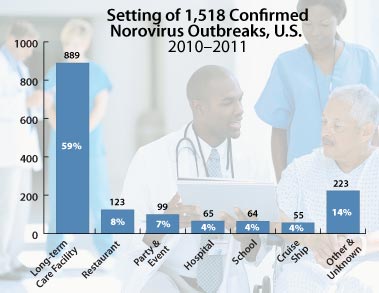Surveillance for Norovirus Outbreaks
 Noroviruses spread when people have contact with infected people, consume contaminated food or water, and touch contaminated objects or surfaces. Outbreaks occur often and can happen to people of all ages in a variety of settings.
Noroviruses spread when people have contact with infected people, consume contaminated food or water, and touch contaminated objects or surfaces. Outbreaks occur often and can happen to people of all ages in a variety of settings.
Noroviruses are responsible for over half of all reported outbreaks of gastroenteritis (vomiting, diarrhea, and stomach cramping caused by inflammation of the stomach and intestines). While the vast majority of norovirus illnesses are not part of a recognized cluster, outbreaks provide important information on how the virus spreads and, therefore, how best to prevent infection.
Norovirus outbreaks occur throughout the year. But, over 80% of the outbreaks occur from November to April. Also, when there are new strains of norovirus, the number of outbreaks tends to increase periodically. This occurred in the winter of 2006 to 2007 with the Minerva strain. However, a new strain that appeared in 2009 (New Orleans) did not lead to more outbreaks (Figure 1).
Most outbreaks are caused when norovirus is spread from infected people to others. But, the virus can also spread by consuming contaminated food or water and touching things that have the virus on them. People can get norovirus illness many times during their lifetime. Outbreaks can affect people of all ages and in a variety of settings (Figure 2).
Norovirus in Long-Term Care and Other Healthcare Facilities
Healthcare facilities, including nursing homes and hospitals, are the most commonly reported settings for norovirus outbreaks in the United States and other industrialized countries (see Norovirus in Healthcare Settings). Nearly two-thirds of all norovirus outbreaks reported in the United States occur in long-term care facilities.
The virus can be introduced into healthcare facilities by infected patients—who may or may not be showing symptoms—or by staff, visitors, or contaminated foods. Outbreaks in these settings can be quite long, sometimes lasting months. Illness can be more severe, occasionally even fatal, in hospitalized or nursing home patients compared with otherwise healthy people.
Norovirus in Restaurants and Catered Events
Norovirus is the leading cause of foodborne-disease outbreaks in the United States. Over half of all foodborne-disease outbreaks due to a known cause that were reported to CDC from 2006 to 2008 were attributed to norovirus (Figure 3).
Food can get contaminated with norovirus at any point when it is being grown, shipped, handled, or prepared. A variety of foods have caused outbreaks. But, foods that are eaten raw, such as leafy vegetables, fruit, and shellfish, are most commonly involved in norovirus outbreaks.
Contamination by infected food handlers (people who prepare or serve foods at a restaurant or other place) probably causes the most foodborne norovirus infections. (See For Food Handlers: Norovirus and Working with Food.)
Norovirus outbreaks can also occur from fecal (stool) contamination of certain foods at their source. For example, oysters harvested from contaminated water and raspberries irrigated with contaminated water have caused norovirus outbreaks.
For more information, see Foodborne Disease Outbreak Surveillance.
Norovirus on Cruise Ships
Over 90% of diarrheal disease outbreaks on cruise ships are caused by norovirus (see Facts about Noroviruses on Cruise Ships). Norovirus can be especially challenging to control on cruises ships because of the close living quarters, shared dining areas, and rapid turnover of passengers. When the ship docks, norovirus can be brought on board in contaminated food or water or by passengers who were infected while ashore. Repeated outbreaks on consecutive cruises may also result from infected crew or environmental contamination. This is because norovirus can persist on surfaces and is resistant to many common disinfectants.
Norovirus in Schools and Other Institutional Settings
Norovirus outbreaks occur in a range of other institutional settings, for example, schools, child care centers, colleges, prisons, and military encampments. Norovirus outbreaks on university campuses have led to campus closures. Norovirus was the most common cause of gastroenteritis in U.S. Marines during Operation Iraqi Freedom and a common cause of outbreaks among British troops deployed to Iraq during 2002 to 2007.
CDC's Role in Norovirus Outbreaks
While most norovirus outbreaks are investigated by state and local public health authorities, CDC coordinates outbreaks that involve multiple states. Such outbreaks may result from contaminated food that is widely distributed to various states or from an event that involves participants from multiple states.
When requested, CDC also provides technical consultation and assistance to state and local public health agencies during norovirus outbreaks. CDC is also working to improve state and local laboratory capacity and can provide diagnostic support, if requested, to help confirm and report norovirus outbreaks.
National surveillance systems for norovirus outbreaks coordinated by CDC include:
- The National Outbreak Reporting System (NORS) collects reports from state and local health departments on all acute gastroenteritis outbreaks, including those spread by contaminated food or water and person-to-person contact. This information is used to determine where norovirus outbreaks commonly occur, how the virus is transmitted, and specific food or water sources involved. In turn, this helps with identifying the best ways to prevent and control norovirus illness and outbreaks.
- CaliciNet is a national surveillance network that includes a database for public health laboratories to submit gene sequences from human caliciviruses (noroviruses and sapoviruses) identified from outbreaks. The information is used to link norovirus outbreaks that may be caused by common sources (such as food), monitor trends, and identify emerging norovirus strains.
Data Sources
- Yen C, Wikswo ME, Lopman BA, Vinjé J, Parashar UD, Hall AJ. Impact of an emergent norovirus variant in 2009 on norovirus outbreak activity in the United States. Clin Infect Dis. 2011;53(6):568–71.
- Vega E, Barclay L, Gregoricus N, Williams K, Lee D, Vinjé J. Novel surveillance network for norovirus gastroenteritis outbreaks, United States. Emerg Infect Dis. 2011;17(8):1389–95.
- CDC. Surveillance for foodborne disease outbreaks --- United States, 2006. MMWR. 2009;58(22):609–15.
- CDC. Surveillance for foodborne disease outbreaks --- United States, 2007. MMWR. 2010;59(31):973–9.
- CDC. Surveillance for foodborne disease outbreaks --- United States, 2008. MMWR. 2011;60(35):1197–202.
More Information
- CDC Norovirus web site
- CDC feature - Prevent the Spread of Norovirus
- For Food Handlers: Norovirus and Working with Food
- Norovirus in Healthcare Facilities Fact Sheet [PDF - 1.22 MB]
- Handwashing: Clean Hands Save Lives
- Put Your Hands Together [PODCAST - 3:48 minutes]
- Foodborne Disease Burden in United States – provides new estimates highlighting norovirus as the leading cause of foodborne illness
- Foodborne Disease Outbreak Surveillance
- Toolkit for Responding to Norovirus Outbreaks In Healthcare Settings
- Tips for Healthy Cruising
- CDC's Vessel Sanitation Program
CDC works 24/7 saving lives and protecting people from health threats to have a more secure nation. A US federal agency, CDC helps make the healthy choice the easy choice by putting science and prevention into action. CDC works to help people live longer, healthier and more productive lives.
Get email updates
To receive email updates about this page, enter your email address:
Contact Us:
- Centers for Disease Control and Prevention
1600 Clifton Rd
Atlanta, GA 30333 - 800-CDC-INFO
(800-232-4636)
TTY: (888) 232-6348 - cdcinfo@cdc.gov






